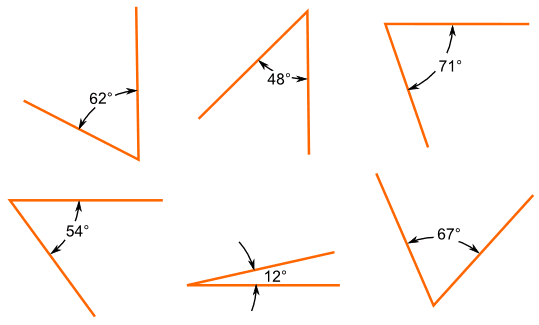Acute Angle
- What is An Angle?
- Definition of An Acute Angle
- Types of Angles
- Solved Examples On Acute Angle
- Practice Problems On Acute Angle
- Frequently Asked Questions On Acute Angle
An acute angle is a fundamental concept in mathematics that refers to an angle that measures less than 90 degrees. In order to understand what an acute angle is, we need to have a clear understanding of angles in general.
What is an Angle?
An angle is a figure formed by two rays or line segments that have a common endpoint called the vertex. The two rays or line segments that form the angle are called the sides of the angle. Angles are commonly measured in degrees or radians.
Definition of an Acute Angle
An acute angle is an angle that measures less than 90 degrees. In other words, an acute angle is a small angle that is less than a right angle. It is important to note that the measure of an acute angle is always greater than 0 degrees.

Types of Angles
Angles can be classified into several different types based on their measures. Here are some basic types of angles:
Right angle: A right angle measures exactly 90 degrees. It is formed when two perpendicular lines intersect.
Obtuse angle: An obtuse angle measures greater than 90 degrees but less than 180 degrees. It is larger than a right angle.
Straight angle: A straight angle measures exactly 180 degrees. It is a line that is folded in half.
Reflex angle: A reflex angle measures greater than 180 degrees but less than 360 degrees. It is larger than a straight angle.
Acute angle: As mentioned earlier, an acute angle measures less than 90 degrees. It is smaller than a right angle.
Solved Examples on Acute Angle
Let's look at a few examples to further illustrate the concept of an acute angle:
Example 1: Determine whether each angle is acute or not: a) 45 degrees b) 100 degrees c) 75 degrees
Solution: a) The angle measures 45 degrees, which is less than 90 degrees. Therefore, it is an acute angle. b) The angle measures 100 degrees, which is greater than 90 degrees but less than 180 degrees. Therefore, it is not an acute angle. c) The angle measures 75 degrees, which is less than 90 degrees. Therefore, it is an acute angle.
Example 2: Find the measure of the acute angle formed by the hands of a clock at 3 o'clock.
Solution: At 3 o'clock, the minute hand points to the 12 and the hour hand points to the 3. The angle between the minute hand and the hour hand is an acute angle. In this case, the angle measures 90 degrees. Therefore, the acute angle formed by the hands of a clock at 3 o'clock is 90 degrees.
Practice Problems on Acute Angle
Now, let's solve some practice problems to further solidify our understanding of acute angles:
Practice Problem 1: Determine whether each angle is acute or not: a) 120 degrees b) 30 degrees c) 200 degrees
Practice Problem 2: Find the measure of the acute angle formed by the hands of a clock at 6 o'clock.
Practice Problem 3: If the measure of an angle is 75 degrees, is it an acute angle?
Frequently Asked Questions on Acute Angle
Let's address some frequently asked questions related to acute angles:
FAQs:
1. Can an acute angle be greater than 90 degrees?
No, an acute angle cannot be greater than 90 degrees. By definition, an acute angle measures less than 90 degrees.
2. How can you identify an acute angle?
To identify an acute angle, you need to measure the angle. If the measurement is less than 90 degrees, then it is an acute angle.
3. Can an acute angle be negative?
No, an acute angle cannot be negative. Angles are typically measured in positive degrees or positive radians.
4. What are some real-world examples of acute angles?
There are numerous real-world examples of acute angles. For instance, the angle between two adjacent walls in a room could be an acute angle. The angle formed by the hands of a clock at any given time could also be an acute angle.
5. How do acute angles relate to other types of angles?
Acute angles are smaller than right angles, obtuse angles, straight angles, and reflex angles. They have a specific range of measures and are used to classify angles into different categories.
In conclusion, an acute angle is a small angle that measures less than 90 degrees. It is one of the basic types of angles and has various real-world applications. By understanding the definition and properties of acute angles, and by practicing with examples and problems, students can develop a solid understanding of this important mathematical concept.